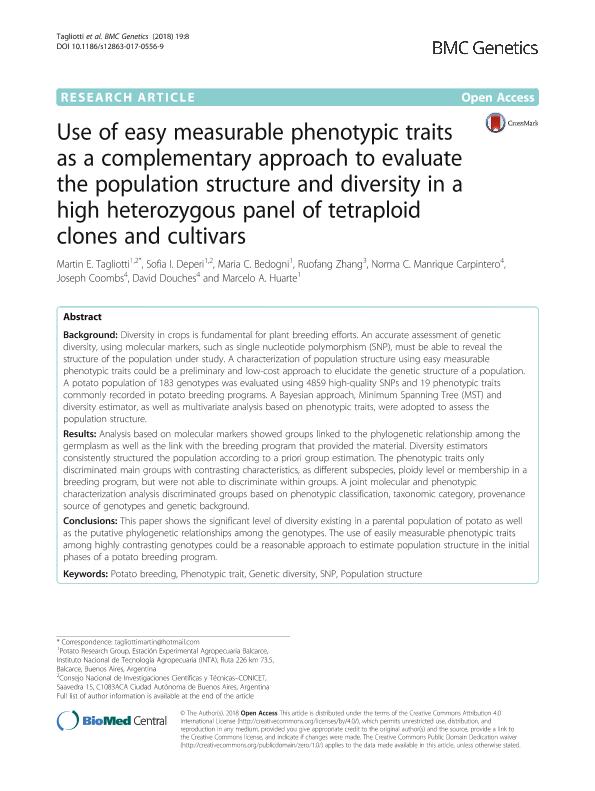Mostrar el registro sencillo del ítem
dc.contributor.author
Tagliotti, Martin Enrique

dc.contributor.author
Deperi, Sofía Irene

dc.contributor.author
Bedogni, María Cecilia

dc.contributor.author
Zhang, Ruofang
dc.contributor.author
Manrique Carpintero, Norma C.
dc.contributor.author
Coombs, Joseph
dc.contributor.author
Douches, David
dc.contributor.author
Huarte, Marcelo Atilio

dc.date.available
2020-03-26T14:57:08Z
dc.date.issued
2018-01
dc.identifier.citation
Tagliotti, Martin Enrique; Deperi, Sofía Irene; Bedogni, María Cecilia; Zhang, Ruofang; Manrique Carpintero, Norma C.; et al.; Use of easy measurable phenotypic traits as a complementary approach to evaluate the population structure and diversity in a high heterozygous panel of tetraploid clones and cultivars; BioMed Central; BMC Genetics; 19; 1; 1-2018; 1-12
dc.identifier.issn
1471-2156
dc.identifier.uri
http://hdl.handle.net/11336/100893
dc.description.abstract
Diversity in crops is fundamental for plant breeding efforts. An accurate assessment of genetic diversity, using molecular markers, such as single nucleotide polymorphism (SNP), must be able to reveal the structure of the population under study. A characterization of population structure using easy measurable phenotypic traits could be a preliminary and low-cost approach to elucidate the genetic structure of a population. A potato population of 183 genotypes was evaluated using 4859 high-quality SNPs and 19 phenotypic traits commonly recorded in potato breeding programs. A Bayesian approach, Minimum Spanning Tree (MST) and diversity estimator, as well as multivariate analysis based on phenotypic traits, were adopted to assess the population structure. Results: Analysis based on molecular markers showed groups linked to the phylogenetic relationship among the germplasm as well as the link with the breeding program that provided the material. Diversity estimators consistently structured the population according to a priori group estimation. The phenotypic traits only discriminated main groups with contrasting characteristics, as different subspecies, ploidy level or membership in a breeding program, but were not able to discriminate within groups. A joint molecular and phenotypic characterization analysis discriminated groups based on phenotypic classification, taxonomic category, provenance source of genotypes and genetic background. Conclusions: This paper shows the significant level of diversity existing in a parental population of potato as well as the putative phylogenetic relationships among the genotypes. The use of easily measurable phenotypic traits among highly contrasting genotypes could be a reasonable approach to estimate population structure in the initial phases of a potato breeding program.
dc.format
application/pdf
dc.language.iso
eng
dc.publisher
BioMed Central

dc.rights
info:eu-repo/semantics/openAccess
dc.rights.uri
https://creativecommons.org/licenses/by/2.5/ar/
dc.subject
GENETIC DIVERSITY
dc.subject
PHENOTYPIC TRAIT
dc.subject
POPULATION STRUCTURE
dc.subject
POTATO BREEDING
dc.subject
SNP
dc.subject.classification
Agricultura

dc.subject.classification
Agricultura, Silvicultura y Pesca

dc.subject.classification
CIENCIAS AGRÍCOLAS

dc.title
Use of easy measurable phenotypic traits as a complementary approach to evaluate the population structure and diversity in a high heterozygous panel of tetraploid clones and cultivars
dc.type
info:eu-repo/semantics/article
dc.type
info:ar-repo/semantics/artículo
dc.type
info:eu-repo/semantics/publishedVersion
dc.date.updated
2020-03-25T14:00:13Z
dc.journal.volume
19
dc.journal.number
1
dc.journal.pagination
1-12
dc.journal.pais
Reino Unido

dc.journal.ciudad
Londres
dc.description.fil
Fil: Tagliotti, Martin Enrique. Consejo Nacional de Investigaciones Científicas y Técnicas. Centro Científico Tecnológico Conicet - Mar del Plata; Argentina. Instituto Nacional de Tecnología Agropecuaria. Centro Regional Buenos Aires Sur. Estación Experimental Agropecuaria Balcarce; Argentina
dc.description.fil
Fil: Deperi, Sofía Irene. Instituto Nacional de Tecnología Agropecuaria. Centro Regional Buenos Aires Sur. Estación Experimental Agropecuaria Balcarce; Argentina. Consejo Nacional de Investigaciones Científicas y Técnicas. Centro Científico Tecnológico Conicet - Mar del Plata; Argentina
dc.description.fil
Fil: Bedogni, María Cecilia. Consejo Nacional de Investigaciones Científicas y Técnicas. Centro Científico Tecnológico Conicet - Mar del Plata; Argentina. Instituto Nacional de Tecnología Agropecuaria. Centro Regional Buenos Aires Sur. Estación Experimental Agropecuaria Balcarce; Argentina
dc.description.fil
Fil: Zhang, Ruofang. Inner Mongolia University; Chile
dc.description.fil
Fil: Manrique Carpintero, Norma C.. Michigan State University; Estados Unidos
dc.description.fil
Fil: Coombs, Joseph. Michigan State University; Estados Unidos
dc.description.fil
Fil: Douches, David. Michigan State University; Estados Unidos
dc.description.fil
Fil: Huarte, Marcelo Atilio. Instituto Nacional de Tecnología Agropecuaria. Centro Regional Buenos Aires Sur. Estación Experimental Agropecuaria Balcarce; Argentina
dc.journal.title
BMC Genetics

dc.relation.alternativeid
info:eu-repo/semantics/altIdentifier/url/https://bmcgenet.biomedcentral.com/articles/10.1186/s12863-017-0556-9
dc.relation.alternativeid
info:eu-repo/semantics/altIdentifier/doi/http://dx.doi.org/10.1186/s12863-017-0556-9
Archivos asociados
